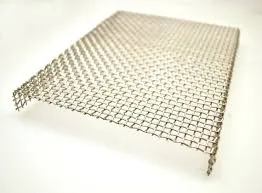-
+86 15030157877
-
sales@galvanizedmetalmesh.com
Oct . 31, 2024 16:39 Back to list
Exploring the Versatility and Applications of Steel Angles in Construction and Engineering
Understanding Steel Angles Importance and Applications in Construction
Steel angles are widely used components in the construction and engineering industries, known for their versatility, strength, and structural stability. Composed primarily of steel, these L-shaped sections come in various sizes, thicknesses, and configurations, making them suitable for a multitude of applications.
What are Steel Angles?
Steel angles are hot-rolled or cold-rolled structural shapes that have a specific cross-section resembling the letter L. They can be equal angles, where both legs are of the same length, or unequal angles with differing leg lengths. Typically measured in inches, steel angles are available in numerous dimensions, and the width of the legs can vary significantly. The thickness and length of the angle can also differ based on the requirements of the project at hand.
Properties and Advantages
One of the primary advantages of using steel angles is their high strength-to-weight ratio. This means they can support significant loads while remaining relatively lightweight, making them easier to transport and handle during construction. Additionally, steel is known for its durability and resistance to weathering, which is crucial for outdoor applications. Other benefits include cost-effectiveness and ease of fabrication, as steel angles can be easily cut, drilled, and welded into place, enabling swift construction processes.
Applications in Construction
Steel angles play a vital role in various construction applications. One of their most common uses is as structural support in buildings and bridges. They are often employed as brackets, lintels, or supports to help distribute loads evenly, ensuring stability and safety. In frames and trusses, steel angles provide the necessary reinforcement and rigidity to withstand external forces such as wind and seismic activity.
steel angle

Another significant application of steel angles is in the manufacturing of machinery and equipment. They serve as essential components in conveyor systems, automotive frames, and shelving units. Their ability to bear heavy loads makes them ideal for use in industrial and commercial settings, where durability and strength are paramount.
Architectural Design
Beyond structural integrity, steel angles contribute to aesthetics in architectural design. They can be exposed in a way that adds an industrial charm to a building. Architects often incorporate steel angles in modern designs, where form meets function. The sleek lines of steel angles can be highlighted through appropriate lighting and finishing techniques, enhancing the overall visual appeal of a structure.
Environmental Considerations
In today's construction landscape, sustainability is becoming increasingly important. Steel angles, when sourced from recycled materials, can significantly reduce the environmental impact of construction projects. The recyclability of steel means that once a structure is no longer in use, its materials can be repurposed, minimizing waste and promoting a circular economy.
Conclusion
In summary, steel angles are essential components in the construction and engineering industries, offering strength, versatility, and aesthetic appeal. Their applications range from structural support to industrial machinery, underscoring their significance in both functionality and design. As construction practices continue to evolve, the role of steel angles will likely expand, reinforcing their importance in sustainable and resilient infrastructure. Whether in a skyscraper, bridge, or a factory, the reliability of steel angles ensures that they remain a cornerstone of modern engineering.
-
Premium Welded Gabion Mesh | Robust & Eco-Friendly
NewsJul.31,2025
-
Premium Eco-Friendly Roof Tiles | Affordable & Durable
NewsJul.31,2025
-
Premium Roof Tiles for Durable & Stylish Roofing Solutions
NewsJul.30,2025
-
High-Quality Roof Tiles for Durable & Stylish Roofing Solutions
NewsJul.29,2025
-
High Quality Square Wire Mesh Manufacturer & Supplier for Wholesale
NewsJul.29,2025
-
Premium Roof Tiles for Durable & Stylish Roofing Solutions
NewsJul.29,2025



